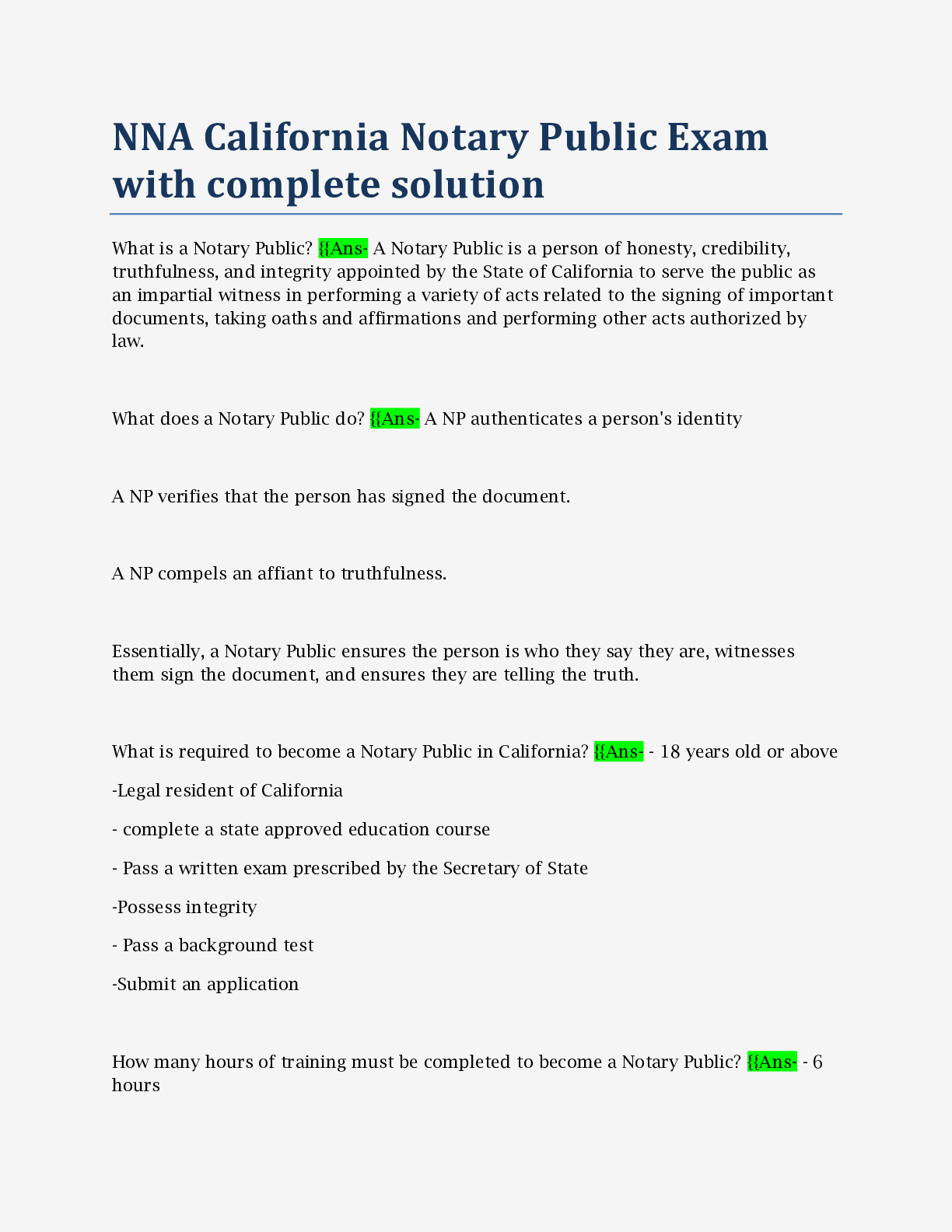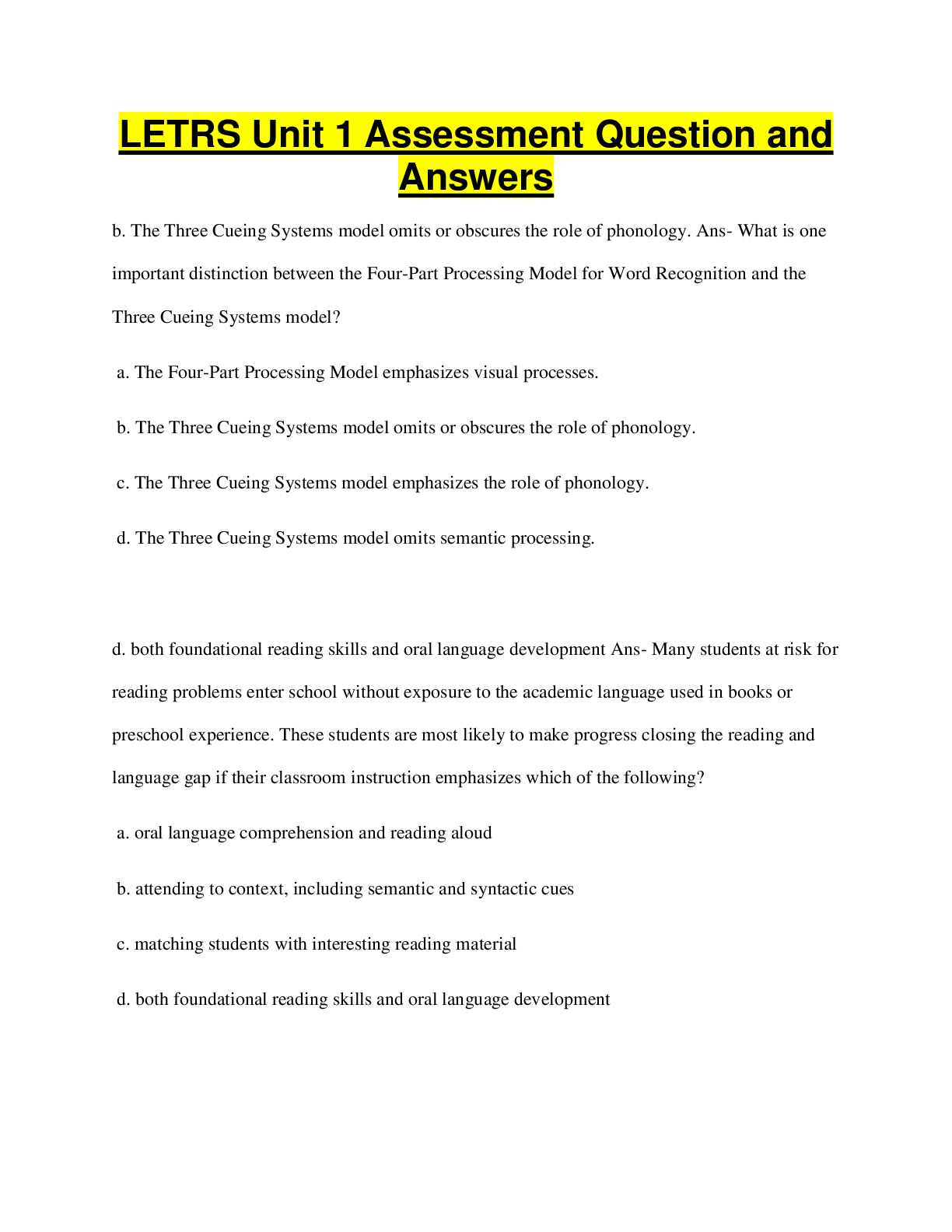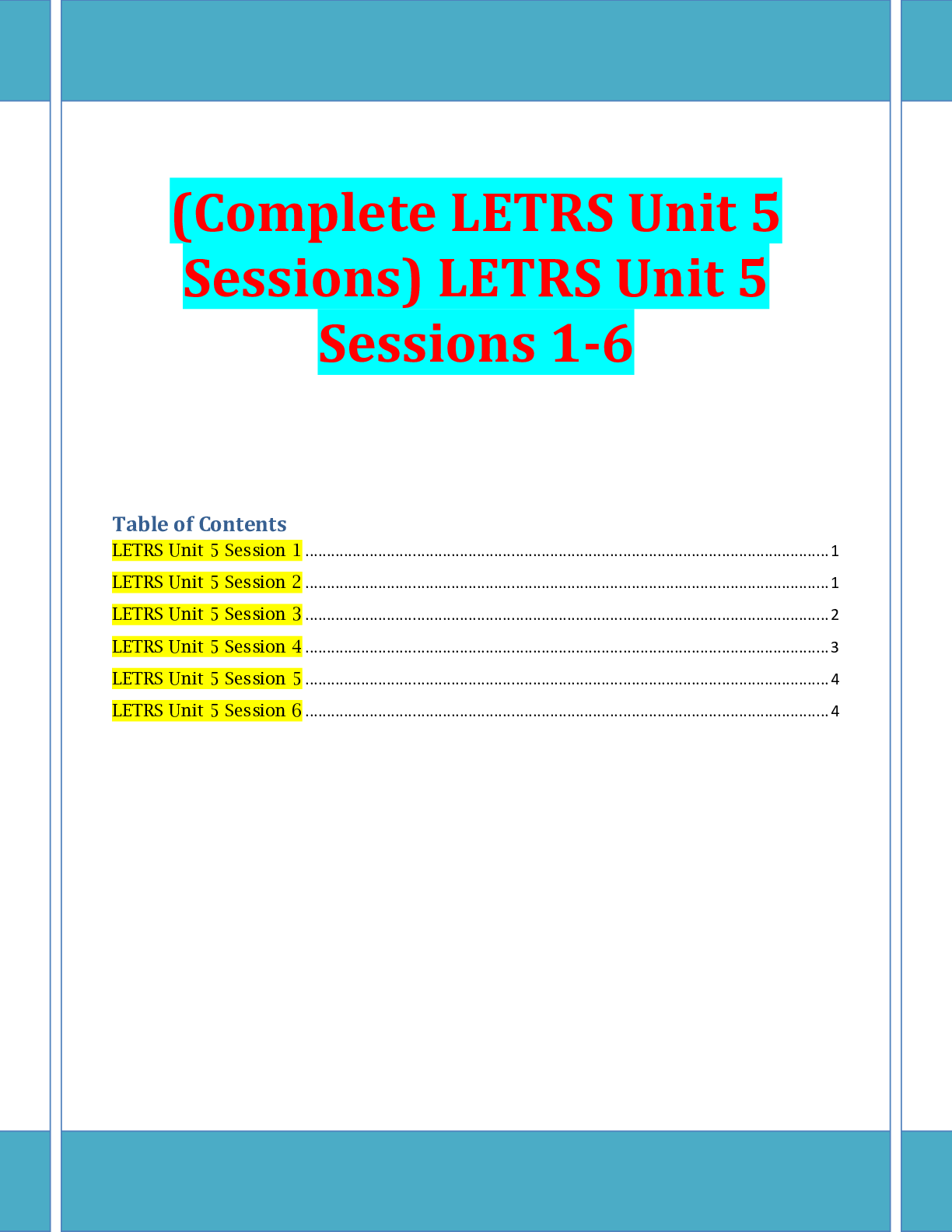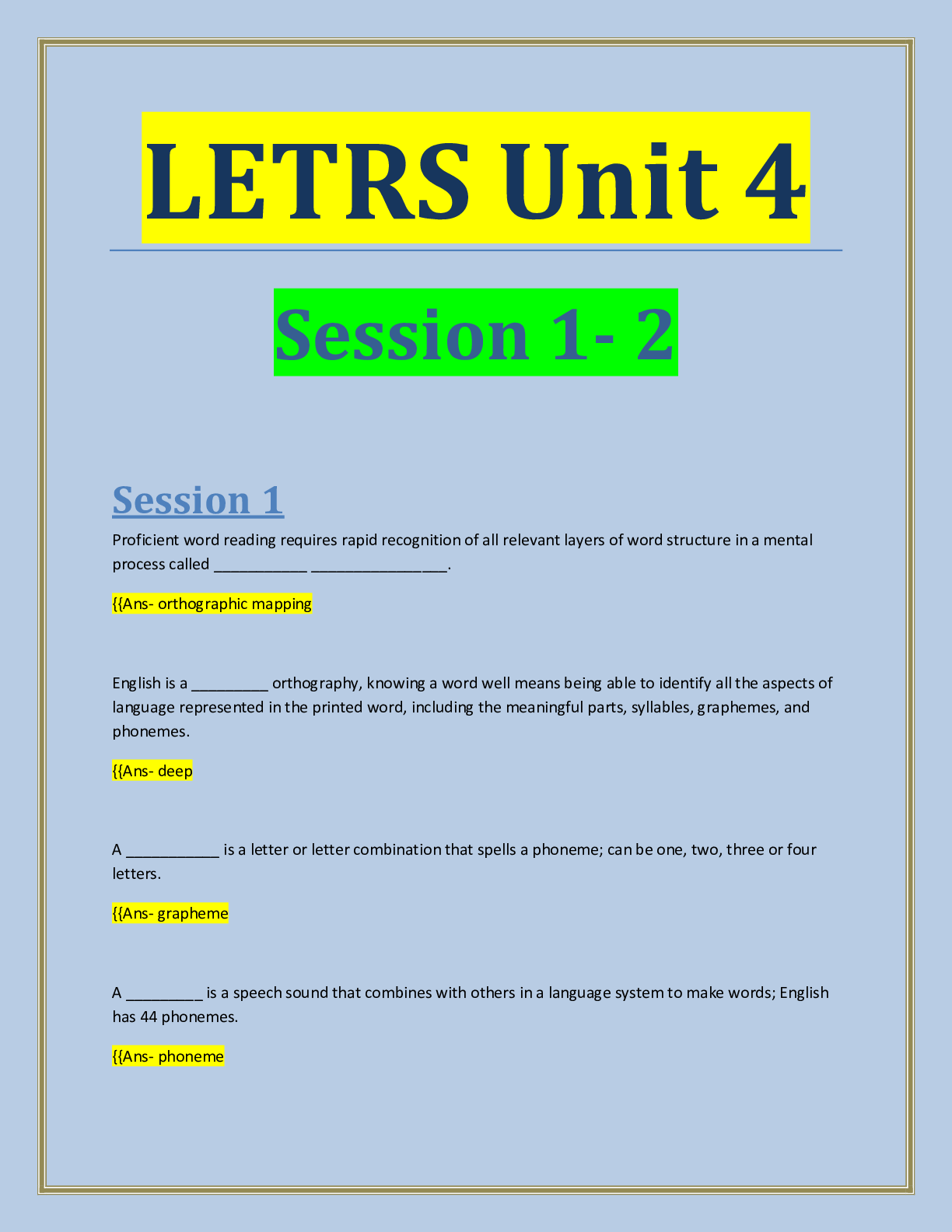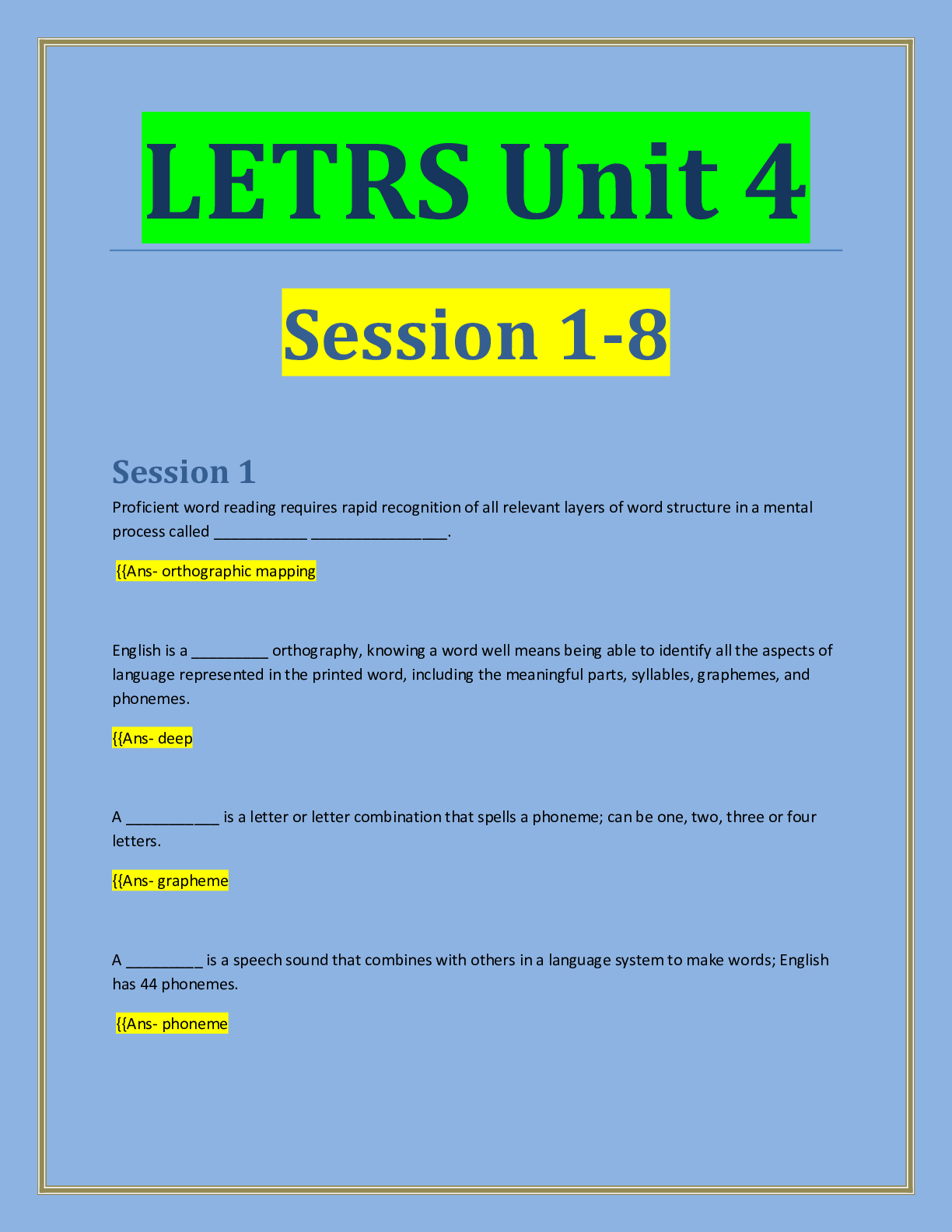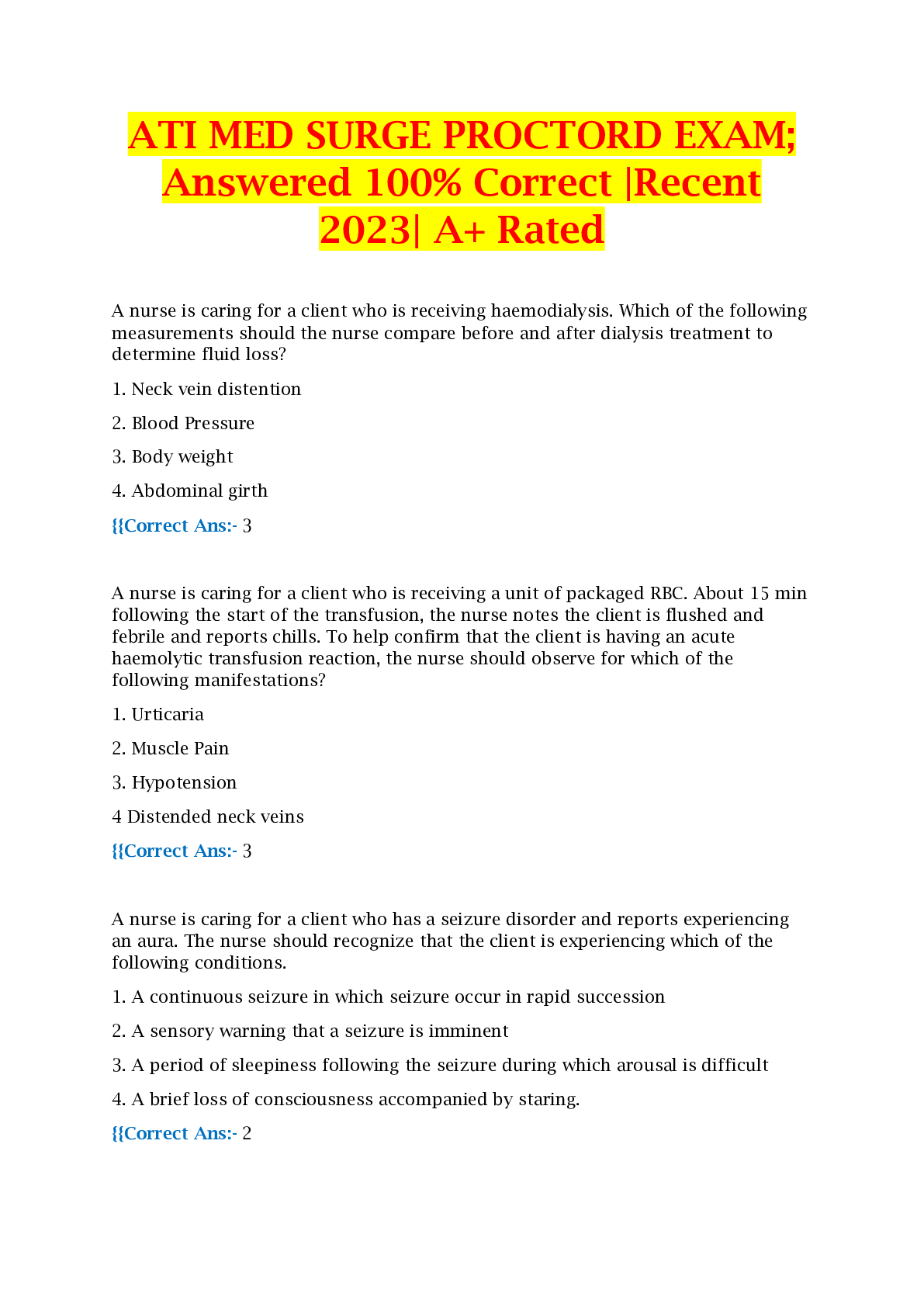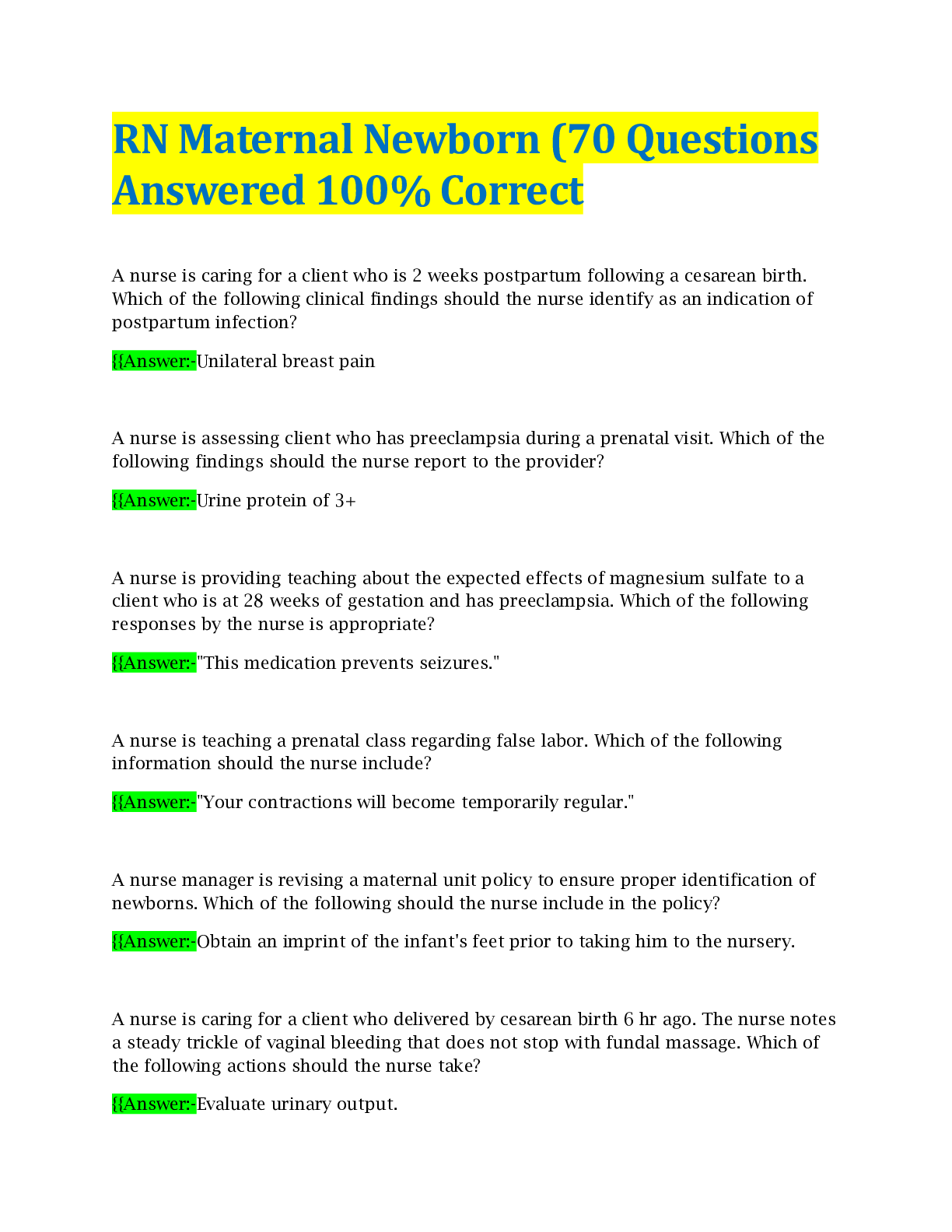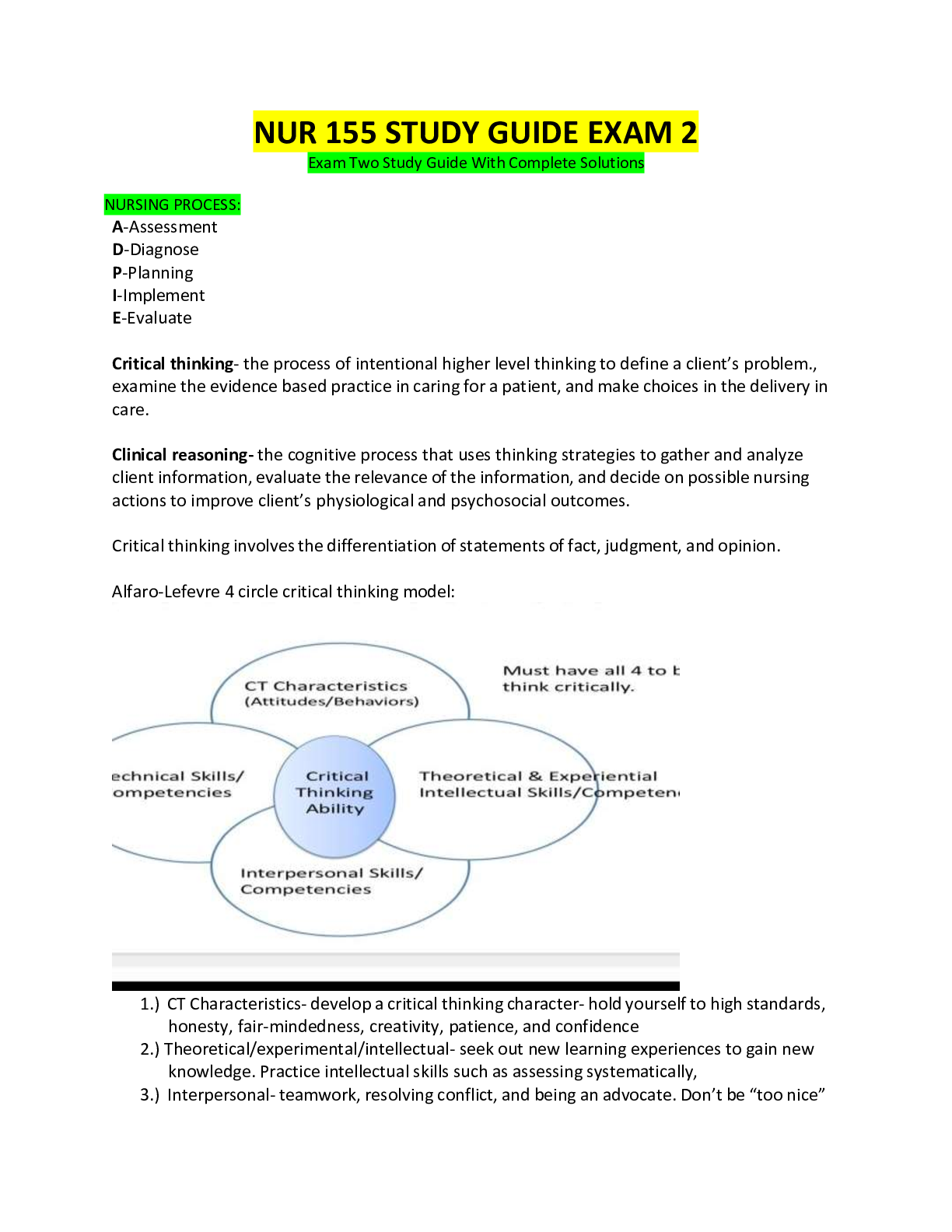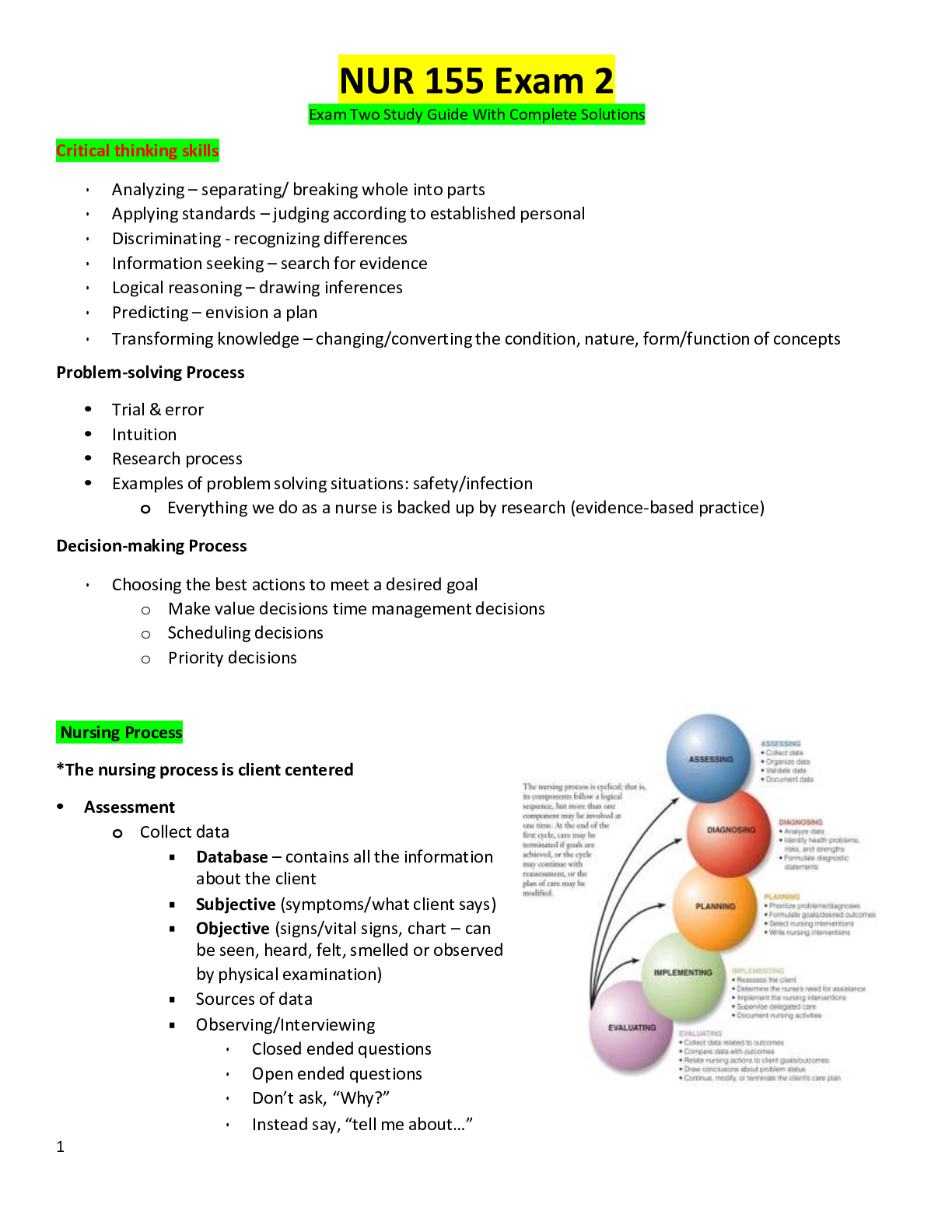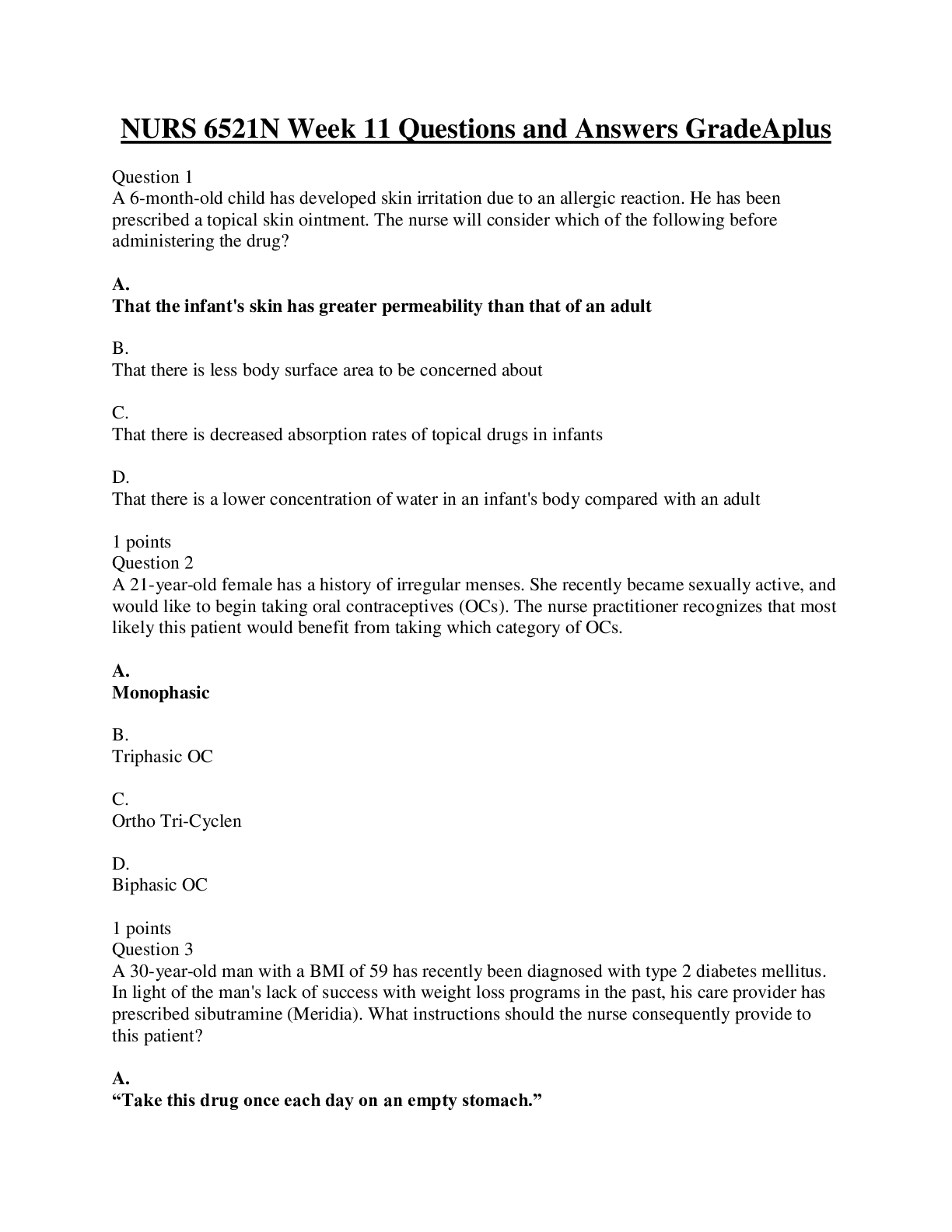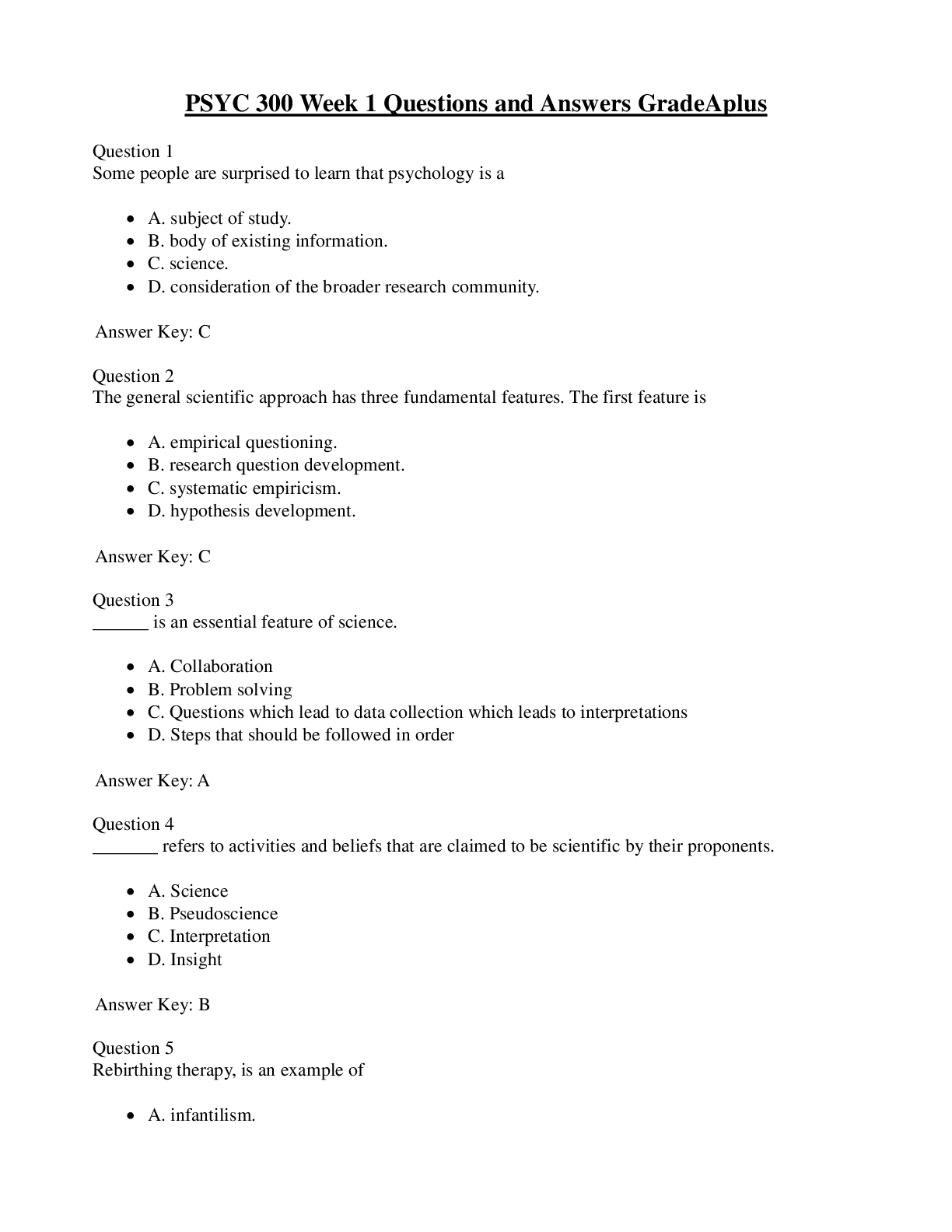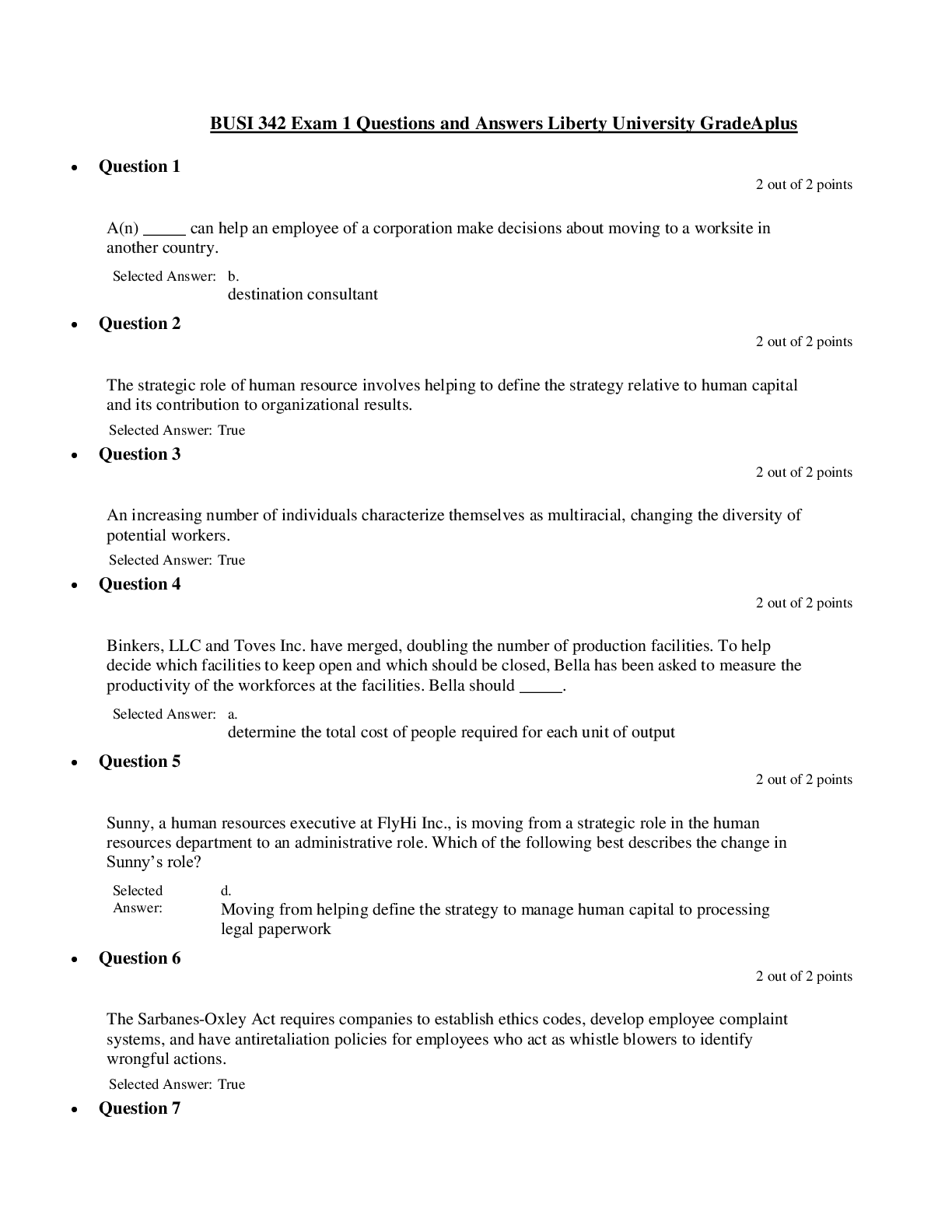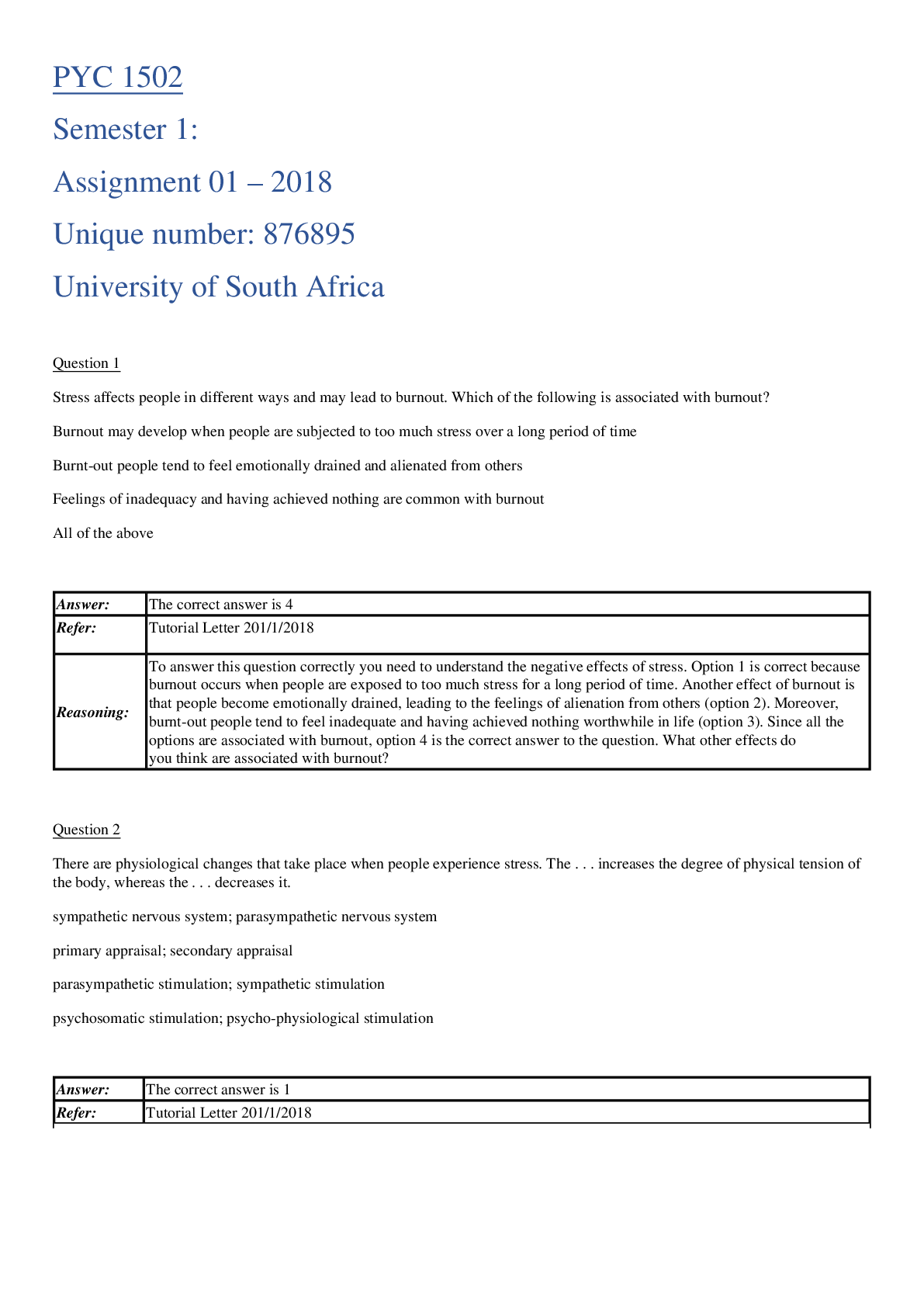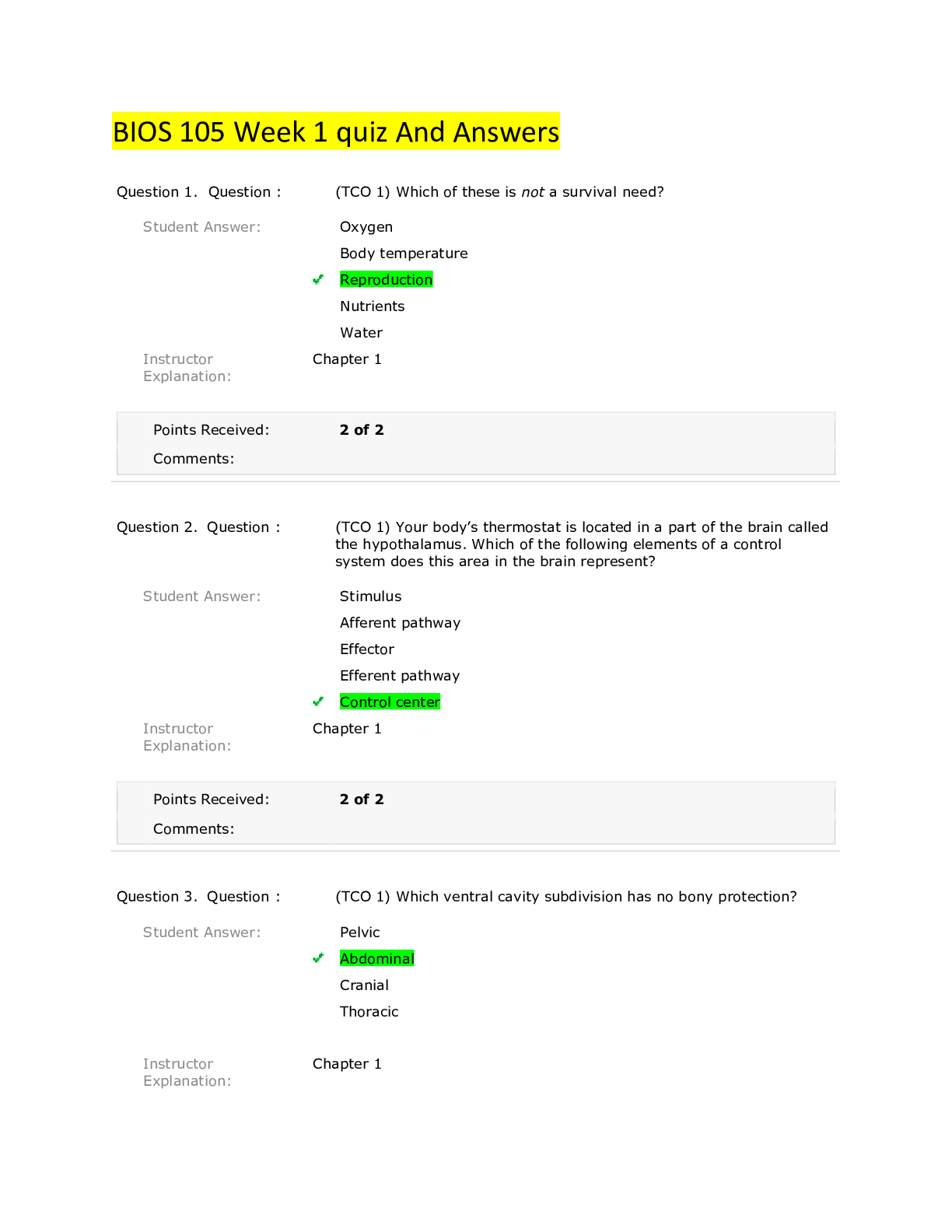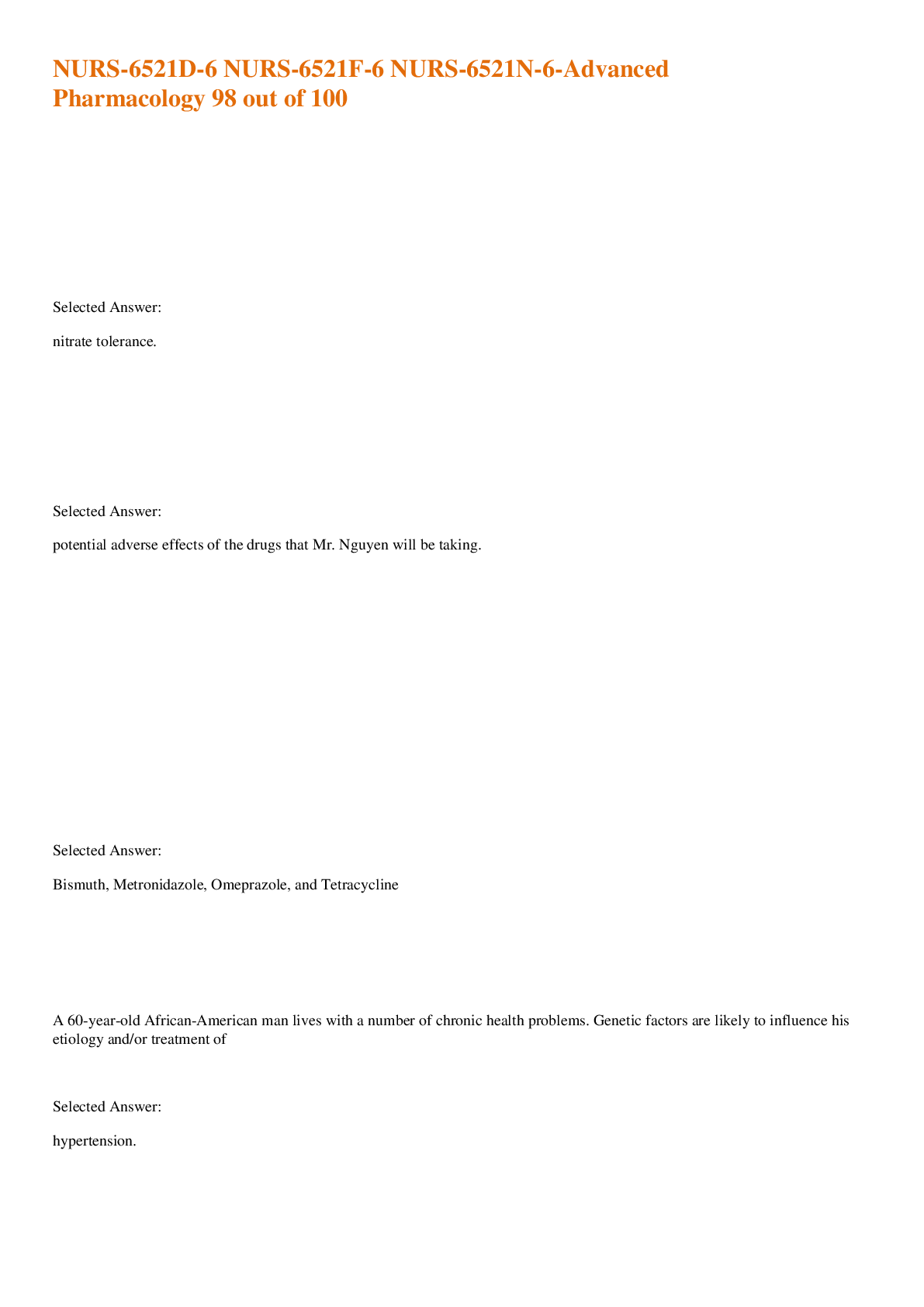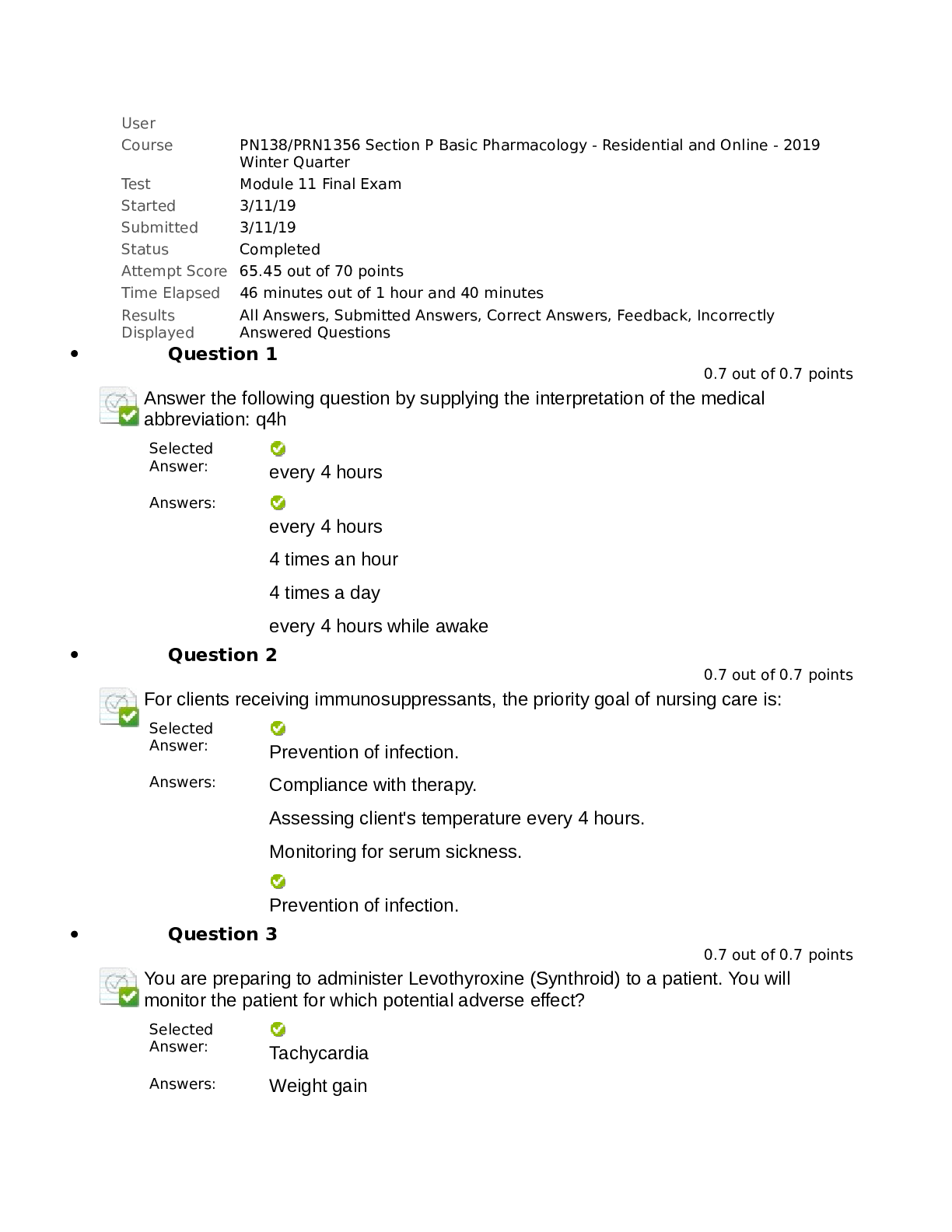NFPT Exam 1 Questions and Answers Latest 2022 with Complete Solutions
Document Content and Description Below
NFPT Exam 1 Questions and Answers Latest 2022 with Complete Solutions When spotting a client doing barbell squats, the trainer should be positoined where? A. In front of the client. B. At the s... ide of the client. C. Behind the client D. Away from the client. A soft tissue structure called a ligament connects what? A. Muscle to bone B. Bone to bone C. Muscle to organ D. Bone to organ Which of the following is BEST recommended for an obese and sedentary client? A. Lunges. B. Olympic lifts. C. Plyometric training D. Low intensity aerobics Which of the following would be the MOST professional way for a trainer to resolve a conflict with an angry client? A. Ignore the conflict and risk angering the client more. B. Immediately terminate the relationship and refuse and reconciliation. C. Call another trainer over and then discuss the conflict openly on the gym floor. D. Listen to the client's complaint in private and discuss resolution options. The Basal Metabolic Rate (BMR) provides the certified personal trainer (CPT) the basis to determine the what? A. Proper caloric intake for meeting the client's goal. B. Client's body mass. C. Adequate repetition range for the client's weight loss. Client's healthy heart rate. Which of the following is a bio-mechanical term? A. Circulation B. Retraction C. Respiration D. Adaptation The result of regular resistance exercises lends to an increase in what? A. Basal Metabolic Rate. B. Low Density Lipoproteins C. Resting heart rate D. Blood pressure The external factors in stress management upon the body are termed by what? A. Physical B. Emotional C. Environmental D. Psychological The three-minute step test is BEST used to assess what fitness component? A. Strength B. Flexibility C. Muscular endurance D. Cardiovascular endurance. Faster repetitions with lighter weights typically increase what? A. Contractile strength B. Flexibility C. Contractile speed D. Hypertrophy How much work capacity is lost at 2% dehydration? A. 1-3% B. 5-8% C. 12-15% D. 20-23% The Valsalva maneuver is generally used by who? A. Aerobic athletes ensuring increased heart rate. B. Anaerobic athletes incorporating a 12-15 repetition range. C. Anaerobic athletes during maximum explosion. D. Endurance athletes experiencing impaired respiratory capacity. Lifestyle choices such as smoking, alcohol abuse, lack of sleep, and constant exposure to negative stress often lead to what? A. Poor health, negative weight loss, poor concentration, and an overall decrease in health. B. An increased sense of well-being, positive attitude, and an increase in general fitness level. C. Lower body fat content, increased muscle growth, and lower cholesterol. D. An increase in general cardiovascular fitness. The Karvonen method calculates what? A. Optimum Training Heart Rate (THR). B. One repetition maximum (1RM). C. Oxygen capacity (VO2 MAX). D. Range of Motion (ROM). Selecting a weight that can be controlled throughout the entire ROM, in strict form; barely being able to complete four repetitions with absolutely no forced repetitions. Sufficient between-set recovery will allow for the performance of the same number of repetitions in the following sets in this particular movement. This statement describes which training principle? A. Rest/Pause B. Overload C. Negative D. Circuit When testing for ROM, it is MOST important to what? A. Massage the muscle groups surrounding the joint. B. Use gentle force to guide the joint through ROM. C. Allow the client to perform the ROM without assistance. D. Facilitate ROM using breathing technique. Which factor does NOT need to be reevaluated by a certified personal trainer after an annual physical for a client reveals a severely elevated cholesterol level and impaired cardio-respiratory capacity? A. Oxygen capacity (VO2 Max) B. Diet C. Range of motion D. Heart rate What is the MOST common reason for a client to fail to get the same number of repetitions in each consecutive set? A. Not eating enough. B. Not training at the same time each day. C. Not getting enough sleep. D. Not waiting long enough between sets. What muscle is the prime mover in a squat? A. Abductors. B. Adductors. C. Hamstrings. D. Quadriceps. By taking pharmaceutical drugs to suppress symptoms, the client what? A. Elevates their fitness level. B. Reduces their risk profile. C. Masks illnesses and disease. D. Increases their wellness. What organelle is responsible for energy production? A. Golgi complex. B. Mitochondria C. Nucleus D. Rough endoplasmic reticulum When would the trainer implement a new program? A. During the consultation and assessment. B. After a review of intake, goals, and type of program. C. On the advice of another trainer. D. On a weekly basis. What is the unit used to measure blood pressure? A. Millimeters of mercury (mmHg) B. Foot pounds (ft/Ibs) C. Pounds per square inch (psi) D. Newtons per second (N/s) What should a trainer suggest to a client who can only weight train one day a week to ensure weight loss results? A. Suggest the client increases water intake. B. Encourage the client to read fitness magazines. C. The trainer should not suggest anything to the client outside of the training session. D. Recommend an additional 20-30 minutes of cardiovascular exercise at least twice a week. What should the client do if they experience a contraindication while exercising? A. Stop exercising. B. Change exercise. C. Reduce intensity. D. Continue exercising. Why is it important to ensure that the client can easily converse with the trainer while performing aerobics? A. To see if the intensity is too great. B. To pass the time quicker. C. To get to know the client. D. To put the client at ease. What is the first thing the certified personal trainer should do if a client is no longer getting results? A. Add more sets to each movement. B. Increase protein intake. C. Increase total calories. D. Reevaluate. The MOST accurate time to obtain resting heart rate is when? A. After exercising. B. After eating. C. Before rising from bed. D. Before going to bed. Recommending long-term, low-level activity, activity prior to eating in the morning, the use of low intensity exercise, and eating more, smaller meals throughout the day all contribute to what? A. An aerobic effect. B. Fat loss. C. Muscle tissue increase. D. Excessive weight gain. Intense weight training on a full stomach can result to what? A. An increase in overall strength. B. Muscle catabolism. C. Nausea. D. Fat loss. If the client experiences pain, dizziness, irregular pulse, and excessive sweating while training, the trainer should do what? A. Refer the client to the appropriate healthcare professional. B. Advise the client to lower the intensity of the exercise. C. Advise the client to increase the intensity of the exercise. D. Have the client stop then resume again once symptoms have passed. Documents that need to be obtained prior to starting an exercise program do NOT include a what? A. Waiver of liability. B. Release and hold harmless agreement. C. Diet profile. D. Certified personal trainer and client contract. Which of the following is commonly known as the prime mover in a concentric muscle contraction? A. Antagonist B. Agonist. C. Synergist. D. Stabilizer. If resistance is applied, when is the muscle tissue MOST vulnerable to injury? A. While the tissue is in a fully contracted state. B. When the tissue is in a relaxed state. C. When the tissue is elongated. D.During mid range contraction. When instructing a client who appears to be confused about performing an exercise, the trainer should do what? A. Raise their voice as they offer more instruction. B. Change the number of repetitions and sets. C. Change the weight because it is apparently too heavy. D. Offer demonstration and more explanation. If a client becomes obviously embarrassed during a discussion about their fitness history, the trainer should do what? A. Acknowledge the embarrassment and encourage honesty. B. Become embarrassed with them. C. Ignore the embarrassment and continue the discussion, D. Postpone the discussion for a later time. Showing the client alternative exercises that result in the same effect will do what? A. Slow progress due to boredom. B. Increase adherence through variation. C. Decrease skills and ability. D. Increase downtime during a workout. What is the valsalva maneuver? A. Forced exhalation against a closed glottis. B. Excessive rate and depth of respiration leading to abnormal loss of carbon dioxide from blood. C. An exercise that impairs or decreases tactile sensibility. D. An exercise that causes overexertion or over strain. The BEST fluid replacement during exercise is what? A. Coffee. B. Energy drink. C. Water. D. Protein shake. Which fiber type has the greatest number of mitochondrial elements? A. White slow twitch fiber. B. White fast twitch fiber. C. Red fast twitch fiber. D. Red slow twitch fiber. An adequate emergency medical plan should be compromised of all of the following EXCEPT what? A. Collecting emergency data. B. Medical equipment and supplies. C. Medical response training. D. Cardiovascular training. Determining the client's level of flexibility is used to identify what? A. Level of strength. B. Overall range of motion. C. Caloric intake. D. Overall health. All of the following are ways for a trainer to obtain continuing education units EXCEPT what? A. Attending professional workshops. B. Participating in online assessment. C. Self-education without examination. D. Completing periodical review and examinations. Which of the following is data that should be collected for emergency situations? A.How many children the client has. B. Client's medical history. C. Previous athletic experience. D. Client's marital status. What is the function of the synergistic muscle? A.To provide balance for the working muscles. B. To fatigue the body during exercise performance. C. To act as the primary muscle in a compound exercise. D. To recover from an exercise. A rating of perceived exertion scale provides a what? A. Subjective measure of exercise intensity. B. Duration measurement for exercise. C. Direct measurement of exercise heart rate. D. Direct measurement of energy expended. Prior to administrating pre-exercise evaluations/diagnostic tests, the trainer should do what? A. Ensure the session has been paid for in full. B. Recommend the client get a complete physical. C. Receive written informed consent from the client. D. Compile an exercise prescription for the client. Which of the following is an exercise where the pectoralis major is the prime mover? A. Lat pull-downs. B. Bench press. C. Bicep curl. D. Lateral raise. Which of the following repetition ranges optimizes growth-stimulating damage? A. 4-6 B. 8-10 C. 12-15 D. 20-25 Which of the following exercises is considered to be anaerobic? A. Treadmill. B.Elliptical. C. Interval step-ups. D. Jumping rope. Which repetition range will effectively solicit muscle recruitment of white fast twitch fibers? A. 4-6 B.10-12 C. 15-18 D. 20-25 The basic direction and strategy of a program is based upon the client's what? A. Goals. B. Income. C. Commitment. D. Ability. Which of the following is NOT good for emotional stress? A. Regular walking. B. Frequent massages. C. Caffeine intake. D. Weight training. When developing a program for a new client, the trainer should address the client's goals after reviewing the what? A. Program based on the client's past experience. B. Client's workout log. C. Notes from the client's previous trainer. D. Data collected during the initial assessment. When using skinfold calipers, it is appropriate to take all the measurements from which location? A. Upper body. B. Same side of the body. C. Both sides of the body, D. Lower body. What exercise is contraindicated for a torn meniscus? A. Chest press. B. Leg extensions. C. Shoulder press. D. Wrist curls. For every pound of weight loss during aerobic exercise, one should consume how many ounces of water? A. 8 B. 12 C. 16 D. 20 Which of the following diets would BEST facilitate weight gain? A. Decrease carbohydrate intake. B. Increase water intake. C. Increase total calories. D. Decrease total calories. To avoid possible conflicts over trainer-client policies, the trainer does what? A. Should inform the client of business policies in advance. B. Should address business policies as they arise. C. Does not need to inform the client of business policies. D. Should not establish business policies. The military press, upright row, and dumbbell lateral raise are all resistance exercises that predominantly target the what? A. Shoulders. B. Chest. C. Back. D. Lower arm. What is the insertion point for the pectoralis major? A. Humerus. B. Femur. C. Radius.. D. Coccyx. Where does the majority of nutrient absorption occur? A. Stomach. B. Small intestines. C. Large intestines. D. Mouth. Why is a squat better for fat loss than a leg extension? A. More muscle is involved, and more fat will be used during recovery. B. There are more fat deposits in the hips than in the legs. C. Leg extensions are too easy to perform. D. A squat results in more labored breathing. What is the BEST repetition range to use to improve muscular endurance? A. 1-3 B. 4-6 C. 1-15 D. 20-25 Long duration, steady-state aerobic activity is primarily fueled by what substrate? A. Fat B. Protein C. Carbohydrate D. Carbon dioxide How many calories per pound of target weight are recommended as guidelines? A. 4 B. 11 C. 22 D. 36 If the client comes to a session complaining that they do not feel well and does not want to work out, the trainer should do what? A. Talk to the client about the seriousness of their condition. B. Offer the client some sugar for immediate energy. C. Ignore the client's conditions and begin the workout. D. Ask the client to leave and come back when they feel better. What is the primary mover in the stiff leg dead lift? A. Quadriceps. B. Abdominals. C. Hamstrings. D. Calves. What is the definition of a healthy individual? A. Absence of disease and illness. B. Having at least 26% body fat. C. Ability to bench press their body weight. D. Ability to run a mile in less than 5 minutes. The wrist can be described as what kind of joint? A. Ball and socket B. Hinge C. Fixed D. Gliding For weight increase or size and strength increase, provide the client with what? A. Basal metabolic rate calories. B. BMR + total expenditures. C. BMR + total expenditures + 500 calories. D. BMR - total expenditures. Which of the following enzymes breaks down carbohydrates? A. Amylase. B. Pepsin. C. Lipase. D. Galactose. When should a certified personal trainer refer a client to a physician prior to training? A. If the client is overweight. B. If the client is over 35 years old. C. If the client has been previously inactive. D. If the client has a cardiovascular risk profile above 32. Stress management is BEST described as what? A. Eliminating all stress in one's life. B. The ability to cope with stress to maintain normal daily activity. C. A defense against burnout and anxiety. D. The belief that nothing is important or can harm you. Which of the following would be an appropriate exercise if the client wants to target the gluteus maximus? A. Squats. B. Leg curls. C. Leg extensions. D. Calf raises. The motor units that contract optimally during very light work are the what? A. Red slow twitch motor units. B. White fast twitch motor units. C. Red fast twitch motor units. D. White slow twitch motor units. The thoracic vertebrae refer to which section of the spine? A. Neck B. Mid back C. Lower back D. Pelvic vertebrae The trainer's expertise is limited to what? A. Assessing the client's lifestyle changes and goals. B. Recommending treatment to the client. C. Prescribing health supplements to the client. D. Diagnosing the client's condition and offering treatment. If the client's Basal Metabolic Rate equals 2,000 kcal, activity expenditure equals 500 kcal, and caloric intake is 2,500 kcal, what physiological response should occur? A. Weight loss. B. Weight maintenance. C. Strength gain. D. Strength loss. A major benefit of regular exercise on the cardiovascular system is what? A. Decreased resting heart rate and lower blood pressure. B. Increased resting heart rate and lower blood pressure. C. Decreased resting heart rate and elevated blood pressure. D. Increased resting heart rate and elevated blood pressure. A client has effectively reached their weight loss goal and now wishes to increase their strength. Which of the following provides the BEST solution? A. Decrease aerobic activity and increase anaerobic activity. B. Increase aerobic activity and decrease anaerobic activity. C. Decrease protein intake and maintain aerobic activity. D. Increase carbohydrate intake and decrease aerobic activity. Which bone connects the pelvis to the tibia? A. Femur B. Radius C. Ulna D. Fibula How does the heart adapt to resistance exercise? A. By beating more often. B. By increasing the size of the right ventricle. C. By increasing the size of the left ventricle. D. Increasing in size and strength. Trainers should practice all of the following EXCEPT what? A. Maintaining CPR certification. B. Securing liability insurance. C. Developing intimate relationships with clients. D. Ensuring client confidentiality. What test can be easily applied to monitor lean muscle loss during low calorie dieting? A. Endurance test. B. Blood sugar test. C. Sub-maximal exercise test. D. Frequent strength test. A baseball swing is in what plane of motion? A. Parallel sagittal B. Transverse C. Sagittal D. Frontal A body composition test is used to determine what? A. Flexibility and strength B. Blood glucose levels. C. Cholesterol levels. D. Lean body mass. Which of the following concepts can be considered injury preventive? A. Maximize overload. B. Slow progression. C. Promote fatigue. D. Increased intensity. Which of the following describes the palm turned upward? A. Supination. B. Pronation. C. Adduction. D. Hypertension. Smoking cigarettes may cause what? A. Vasodilation. B. Lung cancer. C. Weight gain. D. Increase in endurance. Which of the following is a reason for high total cholesterol? A. Overconsumption of unsaturated fats. B. Overconsumption of saturated fats. C. Overconsumption of sodium. D. Overconsumption of complex carbohydrates. Antagonistic muscle groups are what? A. Biceps and triceps. B. Chest and triceps. C. Back and biceps. D. Biceps and biceps femoris. Which type of muscle fiber is found in arterial walls? A. Cardiac. B. Smooth. C. Skeletal. D. Rough. Which of the following exercises involves the biceps? A. Low cable row. B. Military press. C. Bench press. D. Dips. Which of the following is NOT a cardinal sign of a minor acute injury? A. Intermittent pain. B. Complete immobility. C. Mild swelling. D. Skin redness. Which of the following is NOT a preferred means for evaluating lean tissue loss? A. Body composition measurement. B. Muscle strength test. C. Ketone test. D. Step test. If a client cannot do basic squats or leg presses due to a past back injury, which of the following are reasonable exercise alternatives? A. Leg extenstions and leg curls. B. Jump squats and squat thrusts. C. Overload presses and heavy shrugs. D. Front squats and deadlifts. The myofibrils are comprised of what? A. Sarcoplasm. B. Ribosomes. C. Actin and myosin. D. DNA When a muscle contracts at an intensity that would cause serious injury, what mechanism shuts down the contractions? A. Muscle spindles. B. Golgi tendon organ C. Tendon of origin. D. Tendon of insertion. Prolonged resistance training results in a what? A. Increase in lean muscle mass and a decrease in body fat. B. Increase in endurance of about 30%. C. Overall increase in blood pressure. D. Overall increase in resting heart rate. As the intensity of the exercise increases, the primary fuel source shifts from fatty acids to what substance? A. Glucose. B. Amino acids. C. Mineralocorticoids. D. Glycerol. Emotional and environmental stress has been shown to increase abdominal fat accumulation due to a rise in which hormone? A. Testosterone B. Cortisol C. Insulin like growth factor D. Progesterone Which of the following is NOT recommended for the client who wishes to lose body fat? A. Frequent resistance training. B. Longer duration of cardiovascular exercise. C. Ingest more calories than are expended. D. Shorter recovery between sets. All muscle fiber types have the same what? A. Size myofibrils. B. Number of mitochondria. C. Amount of sarcoplasm. D. Internal components. The lateral raise exercise targets what muscle? A. Lattisimus dorsi. B. Pectoralis major. C. Triceps. D. Deltoids. A client's basal metabolic rate is 2,200, their caloric expenditure is 600, and they are consuming 2,200 calories daily. What is the physiological response? A. Weight maintenance. B. Increased endurance. C. Weight loss. D. Weight gain. Outcomes and consequences of negative choices can do what? A. Reduce risk profile. B. Increase quality of life. C. Increase life longevity. D. Increase incidence of disease. Lengthening of the muscle fibers under contraction is what? A. An eccentric contraction. B. A concentric contraction. C. An isometric contraction. D. An isothermic contraction. The time spent between sets in a given exercise is defined as what? A. Recovery period. B. Rest time. C. Cool down. D. Fat burning stage. What energy source MUST account for most of the energy produced in the muscle cell during the performance of immediate, heavy, and intense resistance? A. Liver glycogen. B. Fatty acids. C. Chylomicrons. D. Muscle glycogen. Which of the following is one of the major health risk factors? A. Smoking B. Obesity. C. Depression. D. Allergies Body fat testing will aid the certified personal trainer in determining all of the following except what? A. The beginning amount of total calories to support lean muscle tissue. B. The progress of a fitness program based on changes in body composition. C. When establishing a baseline for reevaluations. D. When determining proper fluid intake. Which of the following is the MOST useful emergency medical device available for emergency response? A. Automatic external defibrillator. B. First aid kit. C. Blood glucometer. D. Ergometer. A multi-set involving the training of two opposing muscle groups back to back is called what? A. Antagonistic training. B. Maximal work load. C. Stacking. D. Aerobic activity. What substance does the body burn during the first seven to ten minutes of cardiovascular training? A. Glucose. B. Fat. C. Proteins. D. Amino acids. To avoid injury when training a specific muscle too often, the client should do what? A. Give the working muscle between 48-72 hours of rest. B. Drink more protein shakes. C. Avoid the gym for one week. D. Wrap the overworked muscle in an ace bandage. For a fat loss client, which of the following types of exercise can and should be performed for as long and often as possible? A. Yoga. B. Power lifting. C. Sprinting. D. Low level activity. [Show More]
Last updated: 1 year ago
Preview 1 out of 18 pages
Instant download
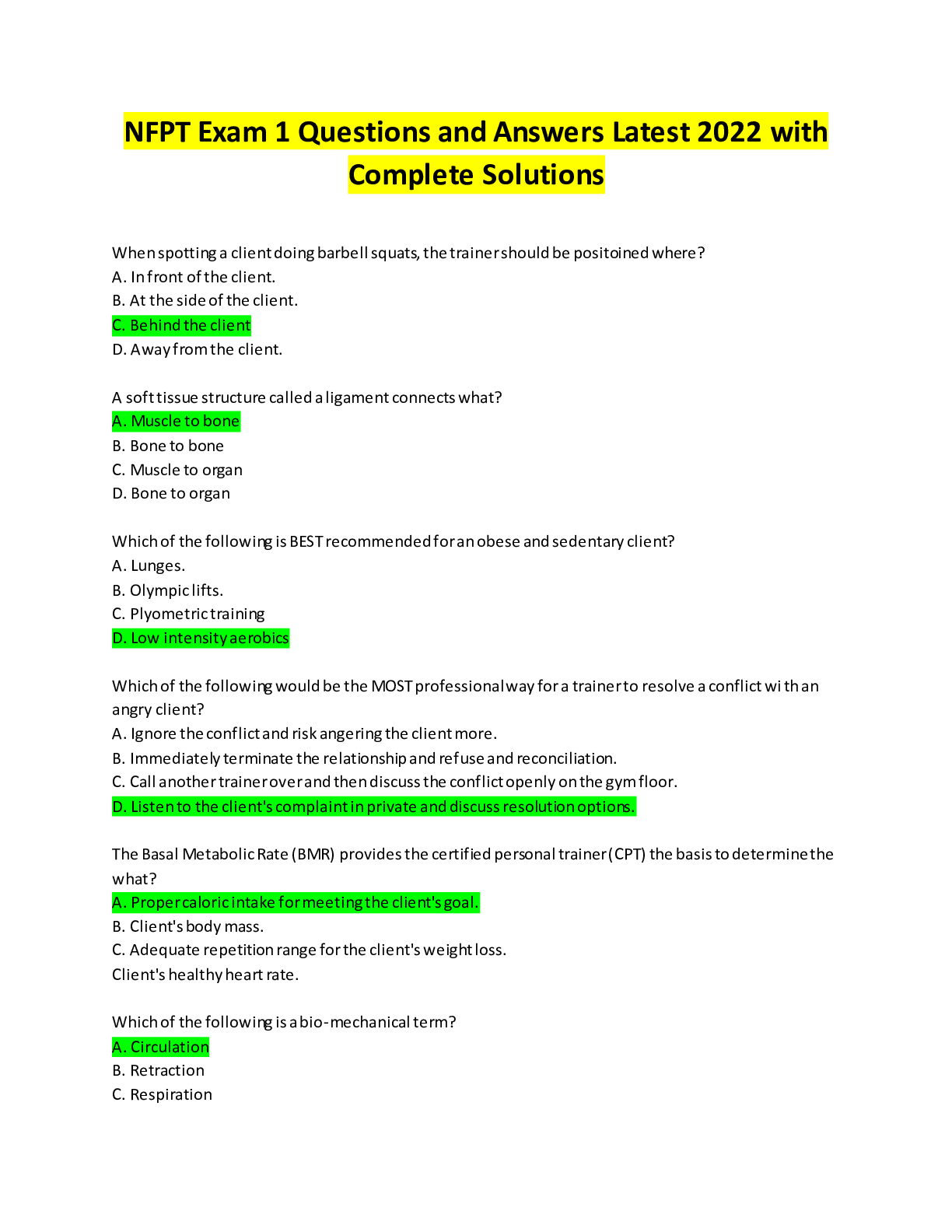
Buy this document to get the full access instantly
Instant Download Access after purchase
Add to cartInstant download
Reviews( 0 )
Document information
Connected school, study & course
About the document
Uploaded On
Jun 06, 2022
Number of pages
18
Written in
Additional information
This document has been written for:
Uploaded
Jun 06, 2022
Downloads
0
Views
92

